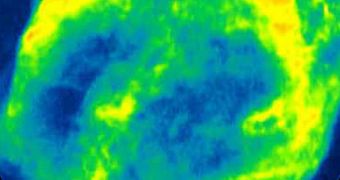When a massive star in the Milky Way's Ophiuchus constellation blew up, it spread rays of light so bright, that they exceeded the brilliance of Mars when they reached Earth, in 1604. Within a few days of the first sighting, the light source was even brighter than Jupiter.
This amazing image was collected using a radio telescope, and its main feature is a semi-spiral of radiations seen at the top of the image (click on it for full resolution). The emissions can be seen here whirling around, most likely under the force of the original blast.
Dubbed SN1604, or the Kepler Supernova, the exploded star is located roughly 20,000 light-years from Earth, Daily Galaxy reports. Scientists say that the progenitor star which led to the supernova event was most likely very massive, considering the sheer force of the blast.
What I find particularly interesting is that many of those looking for extraterrestrial intelligence believe that such explosions may be to blame for our inability to find alien civilizations. Their regions of space surrounding a failed star are drenched in high amounts of radiations, from which nothing can escape.

 14 DAY TRIAL //
14 DAY TRIAL //